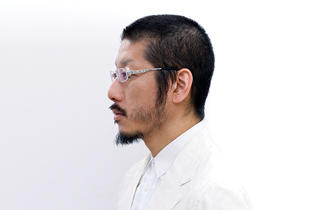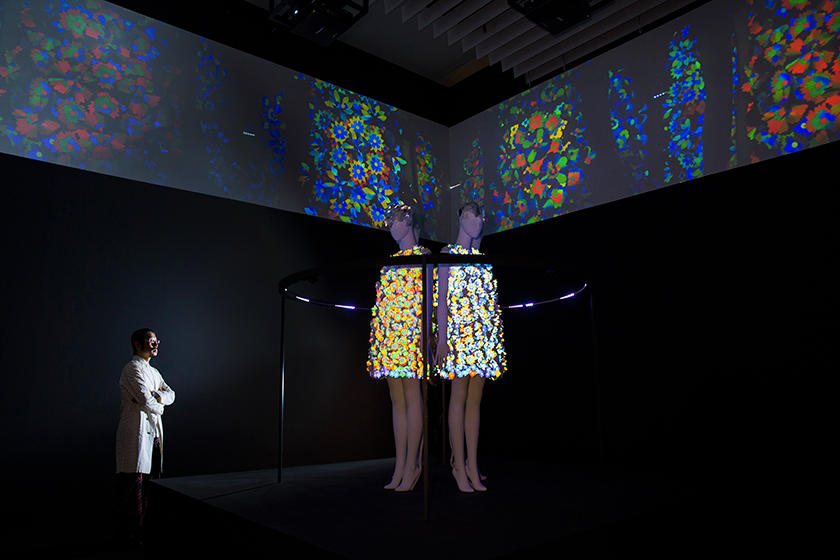
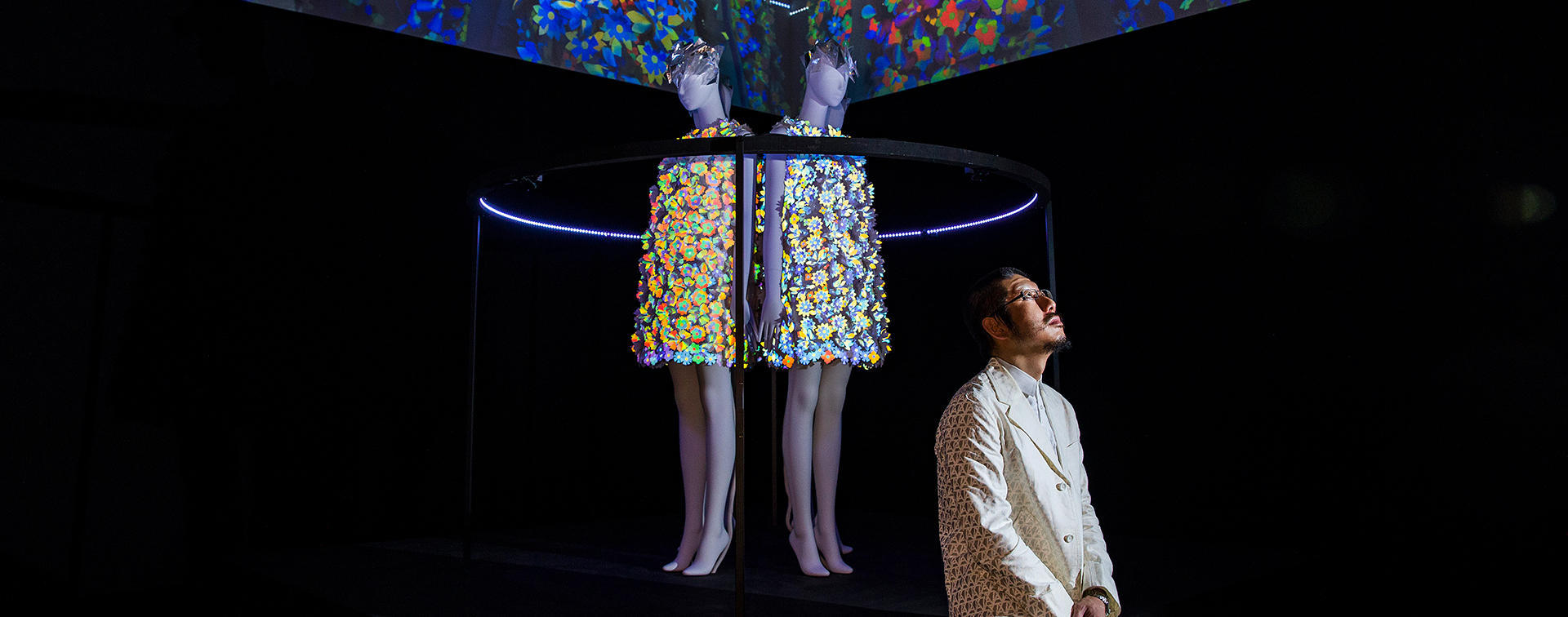

INTERVIEW
103
Kunihiko MorinagaANREALAGE Designer
Clothes that inform people of their surroundings and affect their movements
A desire to continue creating clothes that will change the life of the people wearing them
Fashion designer Kunihiko Morinaga explains that the name of his brand ANREALAGE is made up from the words “real” and “unreal” and “age”. He says that for him, “real” represents the everyday, while “unreal” represents the non-everyday. Based on his firm belief that “God is in the details”, Morinaga creates fashion that takes us by surprise; his works include clothes made from tiny pieces of patchwork, innovative design that do not conform to the human body, and clothes that incorporate technology. He says the theme of his brand is the fluctuation between the everyday and the non-everyday. At the “Roppongi Crossing 2019: Connexions” exhibition currently being held, Morinaga’s works show how he transcends genres, and connects with all kinds of artists. We asked Morinaga about the moves taken in the brand’s 15-year history, his philosophy for making things, and his views on the current and future state of fashion.
Expressing the ephemeral, ever-changing fashion with colors and light
With ANREALAGE, I try to express through clothes, the notion of going back and forth between the everyday and the non-everyday at the "Roppongi Crossing 2019: Connexions" exhibition, the clothes are shown under a slightly more specific theme.
There are two perspectives for this exhibition: things that are alive and things that are not alive which is why one of my works is called "A LIVE UN LIVE". When I was thinking about this theme, I learned that the Kawahara laboratory and the Niiyama research group at the University of Tokyo were studying a liquid called the "low boiling point liquid."
As you know, the normal boiling point for liquid is 100°C (degrees Celsius), but this liquid boils at 34°C. I was fascinated by that, as well as by the fact that the temperature is close to human temperature. When the liquid comes into contact with human skin, it turns into gas and its volume is changed, and I thought we could use this phenomenon to make something flat rise up. Essentially, it's like filling a container with soy sauce; as its volume changes, the soy sauce expands within the container. It is that mechanism which makes the flowers on the clothes open and close.
The change is really meant to happen with the temperature of the human body, but with the exhibition, we had to use static mannequins. In order to make the flowers continually change shape, we placed numerous devices on the mannequins with modules called Peltier devices. We needed to find out if the liquid really does vaporize, and how much amount would be necessary to make the cloth move properly, and so we went through a period of trial and error for about six months, working with the people at the University of Tokyo.
The other theme is "A LIGHT UN LIGHT" which is about transcending the borders of light and non-light. To express this theme, I used a special light-reflective fabric for the clothes; when the fabric reflects light, a prism changes the colors of the light. The colors changes when a camera flash is used, or when a source of light comes in close proximity of the clothes; a white dress becomes a totally different color.
Fashion is ephemeral and is always changing. It's natural for designs to change; just as time always flows through the four seasons of spring, summer, autumn and winter, fashion continues to flow. The wish to express that transience with colors and shapes was the reason I started making the recent works. Fashion never stands still, and I wanted to express that with flowers which open and close and which change color according to light. With "A LIGHT UN LIGHT", we also used water called "low boiling point liquid"; water which is the source of life and by using water as a motif, and incorporating the changes and phenomena that occur in the world of nature, I think I was able to meet the challenge of doing something new.
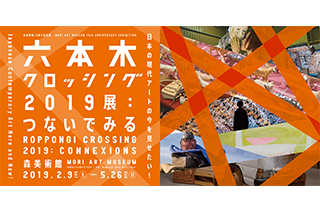
Mori Art Museum 15th Anniversary Exhibition "Roppongi Crossing 2019: Connexions"
Since 2004, the Mori Art Museum has held the "Roppongi Crossing" exhibition every three years to give an overall view of the Japanese contemporary art scene. On display this year are works by 25 artists and collectives, mostly born in the 1970-80s. The works express connections through ways such as joining polar opposites, fusing foreign elements, and making visible the already-existing but invisible bonds.
Exhibition held Feb.9 (Sat)-May 26 (Sun) 2019
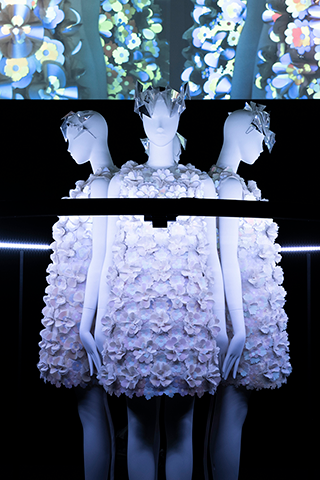
"A LIVE UN LIVE"
An installation by Kunihiko Morinaga shown at the "Roppongi Crossing 2019: Connexions". Four mannequins representing the four seasons of the year wear dresses covered with flowers that continuously close and open; a pouch motor developed by the Kawahara laboratory and Niiyama research group at the University of Tokyo was used for the movement of the flowers. The flowers constantly change color as the angles of reflection change with the changing shape of the petals. Another characteristic of this work is that when photographed with a flash, the originally white dresses become a different color.
ANREALAGE "A LIVE UN LIVE" 2019
Mixed media installation Dimensions variable
"Roppongi Crossing 2019: Connexions" Mori Art Museum (Tokyo)
Expressing a big theme in five-year spans
ANREALAGE is now in its 15th year, but the theme of "the everyday and the non-everyday" which was also the underlying theme for the work presented at "Roppongi Crossing 2019: Connexions", has remained the same. But during the past 15 years, notable things have happened about once every five years or so.
In 2003, I got together with two of my friends and started working independently. In the beginning, we spent long hours to complete just one piece of clothing. We did things that large apparel manufacturing companies cannot do such as creating intricate patchwork and detailed decoration ― I think we were quite tenacious. (laughs) By using our hands and adding things, we were able to create very powerful clothes, but there was a limit to the number of clothes the three of us could make. And we reached a point where we realized that businesswise, we were not doing things right. But we knew it would be impossible to create clothes of the same ambience if we were to mass-produce them in a factory. So although we had been making things by hand for about five years, we decided to stop doing that.
Changing directions, we started to do a lot of thinking instead of using our hands. We thought long and hard about the shape of each shirt and each jacket, and tried to make clothes from a perspective that was different from those of other people's. It was then that I thought of getting the clothes drastically away from the human body. Clothes are usually made to fit the human body, but we made clothes that were not in line with the human shape. For the "〇△□" (2009 S/S Collection), the prototypes were shaped like globes and triangular pyramids. No one has a globe-shaped body, so the thinking behind that was to make clothes that don't fit anyone. Because the clothes don't fit anyone, you could say we were also trying to make clothes that possibly everyone could wear. The prototype is the absolute template for clothes, but changing the prototype led to the creation of clothes with a new standard. After that, there was a phase that lasted about five years where we took the approach of making distinctive shapes.
At the same time, I encountered technology in different fields such as 3D and photochromic technology where colors change according to how light is emitted. That led us to make clothes in another way. We applied technology to clothes, using the skills that have become common in our everyday lives. It happened to be just around the time that our brand marked its 10th year. We stopped making clothes in the way we had been doing and adopted, as it were, a different set of tools. Looking back, I feel it was at this point that we were able to create things that were truly different from what other people were making. It was also around this time that we participated in the Paris Fashion Week shows.
After 10 years, we spent about four-and-a-half years on the "light series"; we were consecutively creating one work after another. The first theme was "SHADOW" followed by "LIGHT" which was about light inside the shadow; that was followed by "REFLECT" which was about reflecting the light. After that it was "PRISM", leading us to create things that changed color. The last in the series was "CLEAR" which was about the darkness swallowing up the clear light and which completed it all. Inevitably, a big theme is not easy to digest. So we approached the theme from many angles and completed the series over a period of about five years. But when we started, it wasn't as if there was a goal in sight. We thought a lot about the theme and we gave shape to the things we encountered on a moment-to-moment basis, and as a result, the works were ultimately connected to each other.
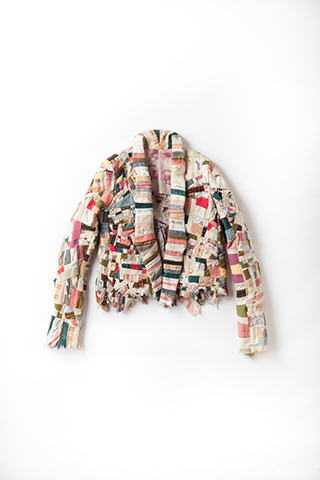
The handcrafted works of ANRELAGE's early years
Since its establishment, ANRELAGE's philosophy has been "God is in the details", and its clothes have shown remarkable attention to the smallest detail. The handcrafted works of the first five years have particularly intricate details. These include items of over-the-top craftwork such as patchworks made of extremely small pieces of cloth and a jacket on which 10,000 buttons have been sewn. The brand's philosophy and design sense of those early years continues intact.
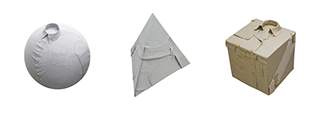
『〇△□』
"〇△□" was the theme of the 2009 S/S COLLECTION. The collection consisted of shirts, trench coats, and cut-and-sew items in the shape of globes, pyramids and boxes. At the exhibition, the clothes were displayed on human-shaped dummies, showing that they can be worn as ordinary clothes. This collection marked the end of ANREALAGE's phase of handcrafted items and spurred the brand's creative momentum.

Underneath the "destructive" appearance of new works is a profound respect for clothes
The things I've made are aggressive, but I myself am a very neutral person. Our theme is the everyday and the non-everyday, and our brand logo consists of the letter A on top of the letter Z, but I don't have a preference for expressing one side over the other. Both sides have their value and I like giving expression to how they mix and overtake the other. Perhaps I am not very self-assertive. If you look at only the surface of what we have made so far, it might seem as if I've used various themes to be destructive toward clothes, but I actually have a profound respect for the themes and the clothes.
While I use technology in making clothes, I myself am a liberal arts person. It's so difficult to convey things in fashion. Many of the designers in the world are designers who work instinctively, and there is the notion that you can't work in fashion unless you have style and sense and instinct. But I think that if you lack something, you can make up for it by teaming up with other people. You need to cooperate with a lot of people in order to create fashion. And when you think of that, you realize how important it is to verbalize your thoughts. Words are vital in conveying to others what kind of image you have in mind ― what kind of clothes and what kind of collection you want to make. With each collection, the first thing I do is not to design, but to put my thoughts into words and to share my thoughts on what I want to make with the staff. If the staff is having hard time understanding the theme, then I decide that the theme itself is too difficult.
Once we get started, things can go forward speedily, but deciding on the theme is the tough part. Of course, in the beginning, there were so many things I wanted to make, but having made thousands of clothes for 30 seasons over the last 15 years, making clothes has become routine as having meals. Now I partly decide on themes by remembering what I used to want to make.
To be honest, there have been times when I felt lost and thought I wouldn't be able to create any more. Recently though, I've changed and I've started to get back that feeling I originally had when creating was such a pleasure. There are quite a lot of things I want to make. At the moment, I'm interested in old clothes. I want to make old clothes and I don't mean processing clothes to give them an old look. I want to make things that would shake the notion of "used clothes" or "vintage". I think I enjoy changing the images that people have of certain words.

Things that are overlooked by viewing fashion on digital screens
In the last few years, I've found hints for my themes from things around me, but about six months ago, I started seeking hints from clothes. So my "experimental box" in which I place things that interest me, has become filled with details on clothes. (laughs)
The theme for the latest collection this season is "wearing the details." With every show, I always do the opposite of the theme. For instance, with the "SHADOW" collection, I made white shadows instead of black shadows, and with the "CLEAR" collection, I made the clear things black. I've placed importance on expressing the opposite of the theme. With this season's "DETAIL", I thought about how I could betray people's expectations of what they think of as details. There is the notion that details are about small things, so I thought of betraying that notion. As a result, I came up with the idea of enlarging the details of clothes and wearing them. For example, wearing only the collar of a trench coat or a shirt, or wearing only the hood of a mods coat or pullover or only the sleeve of an MA-1 flight jacket.
These days, the digital screen is where clothes are mainly shown and seen. Everything is displayed on the screen of a personal computer or smart phone, and people buy things or show things and we think we understand it. But when I thought about what we are losing sight of by doing that, it occurred to me that it's the sense of scale. Before releasing our latest collection, we showed the details of all the clothes on Instagram. On the screen, the sleeves and hems look ordinary. At first, we got an excited response of "Is ANREALAGE releasing very ordinary clothes?" But when we held the show, people saw that the details themselves were the clothes, made on a ridiculous scale. It's not my intention to send a warning message or anything; I just wanted to fill in a hole that has appeared in way we do things in fashion today. By showing our works like that, I think we were able to communicate well with the people who keep an eye on what we do.
The "A LIGHTUN LIGHT" show held last year marked our brand's 15th anniversary; it was like a compilation and I put my heart and soul into it. We showed about a hundred items in around 40 minutes: I concentrated so much on the collection that it was like doing spiritual training. People were wondering what I would do next, and this time we did "DETAIL" which is drastically different. It's light-hearted and makes us chuckle a bit. I wanted to show people that we're trying to change by attempting new things, and I think we were able to get that message across with our latest collection.
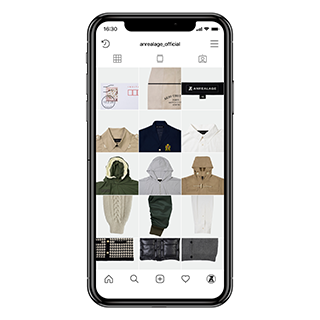
"DETAIL"
The theme of the 2019-2020 A/W COLLECTION was details. Stemming from Morinaga's wish to create clothes that could not be wholly conveyed or grasped via digital screens, the innovative collection consisted of parts of clothes made in overblown sizes and worn as clothes. The works showed the contrast between physical reality and virtual reality. Marking the 15th anniversary of ANREALAGE, the show also made the point that the brand's philosophy is "God is in the details."
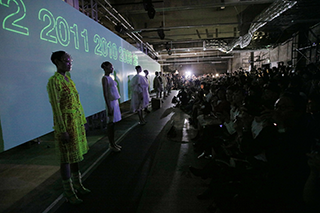
"A LIGHT UN LIGHT"
A show that was held at AMAZON FASHION WEEK TOKYO as part of a special program dubbed "AT TOKYO." The brand's first show in Tokyo in four years, it displayed a hundred clothes, ranging from works released in the first collection in 2003 to the S/S "CLEAR" collection in 2019. For a period of four and a half years, Morinaga had used technology to express light in his clothes and the show marked the completion of the "light" series;
The exciting mood and the discerning tastes in Paris
We held "A LIGHT UN LIGHT" and participated in Japan Fashion Week, but it was the first time in a while for us to hold shows in Tokyo. Cities seem to have their own color; in Paris, elegance is clearly the axis or standard for evaluation. It's totally different in Tokyo where all kinds of values seem to be jumbled together. In Paris, many of the visitors to the shows seem to be from a select circle of fashion experts, but in Tokyo, there are all sorts of visitors including creators who make things that have nothing to do with fashion. I think it's great that I can stimulate people by showing fashion in a place that attracts such a wide range of people.
The attractive aspect of Paris is that during Paris Fashion Week, the streets are filled with fashion and the city becomes excitingly alive. When you get on a taxi, the driver asks "Which venue are you going to?" and naturally strikes up a conversation. And of course, Paris Fashion Week draws many people who have seen genuine things, and so you are surrounded by people with a keen eye for beauty. Tokyo is a remarkable city with regard to fashion; its brands and shops and people are distinctive and strong. In areas other than fashion, there are many outstanding creators and artists who have stepped out of Tokyo and gone abroad. By interacting with such people in other genres, I think the fashion week in Tokyo could become a unique event of the sort not seen in other cities.
Playing hide-and-seek wearing clothes that respond to space
As for what I would like to do in Roppongi... Last year, we did a project called "echo" at Miraikan (National Museum of Emerging Science and Innovation) with Daito Manabe-san and Motoi Ishibashi-san of Rhizomatiks and Akira Hiyama-san of Dialog in the Dark; the project was about updating the methods for sensing things and creating new sensory perceptions.
In the world of fashion, the sense of sight is more important than any other sense, but this project started because I think that fashion can have a role for people who do not rely on sight, and I wanted to overcome the boundaries of fashion and broaden the function of clothes beyond just dressing up. The "echo" project is about clothes expressing the world of special senses that blind people live in.
In the project, we got hints from the white cane that people with impaired vision use to help them with their senses. We developed clothes with skin-like organs which enables the wearer to perceive distance. Bats emit ultrasonic sounds to measure the distance between themselves and their surroundings. We thought we could adapt that for humans. We depend so much on sight in our daily lives, and don't use the senses of hearing, touch and smell, but people without sight are much more sensitive than us about the echo of the sounds they emit, and they can sense the distance between themselves and the buildings and obstacles around them. We incorporated that perception into clothes so that the wearer can experience how a person with impaired eyesight senses clothes and space.
Explained simply, the clothes are equipped with sensors that perceive space so that even in the pitch dark where you cannot see anything, the distance between yourself and the things around you can be calculated. It's a mechanism where you are informed about space with the sensor responding and vibrating when you come near an obstacle. You can walk about blindfolded by relying on the vibrations. This project was about sensing the surrounding environment, but by making precision adjustments, it would be possible to sense the stars in the night sky, or minute things that are not visible such as mites and fleas. It would be fun if all kinds of people wore this and played games like hide-and-seek and tag. When people get the sense of mobility according to their surrounding environment, how will they move? How would the signs in the streets be changed? I'm very keen to know the answers to those questions.
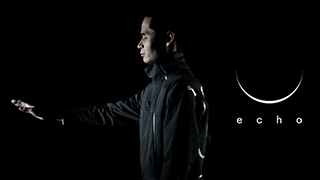
"ECHO"
A project to pursue the new possibilities of clothes by giving clothes the function of a body organ. Consulting with visually impaired people, ANREALAGE, Dialog in the Dark, and Rhizomatiks Research created "ECHO WEAR" which responds to surrounding space. The wear emits signals, monitors space by measuring distance and responds with vibrations. It allows the wearer to be aware of space without relying on eyesight and is the world's first such piece of clothing.
Fashion needs to be different and yet be widespread
The recent project is just one example of what we can do.; I think there are all the kinds of things that we could with fashion in the future. Fashion is very much a cultural thing, and it's possible to mingle fashion with art and music and many other genres. I hope that with fashion as our common interest, I will be able to continue interacting with all kinds of people and incorporate many different things that lie beyond the confines of fashion.
Yet the more I do that, the more I feel as if I am distancing myself from the core of fashion. Fashion seems to be a phenomenon characterized by two elements that are in extreme opposition to one another. On the one hand, fashion is about being different from other people, and through fashion you can gain privilege. But fashion is not only about that; it's also about mixing in with many people and becoming widespread. Yet when it becomes too widespread, it is consumed and risks no longer be called fashion. It's difficult, but I suppose the bipolar opposites are necessary.
Sometimes I hear people say that the Japanese fashion scene these days is not interesting. Perhaps one reason is that people are spending their energy in a wider range of interests. This is not only true of fashion but of other fields: the options are broadening and you can buy all kinds of content. I think what people call interesting fashion has always been a small part of fashion. I believe interesting fashion still exists and its size is probably about the same as before. The number of clothes has grown considerably due to fast fashion and the second-hand market, and maybe that is why it appears as if interesting fashion has become hidden.
Clothes for daily wear are very important. We absolutely need designers who can make clothes to wear on a daily basis. There are many such designers in Japan, so I feel secure about that. That is precisely why we want to make clothes that look ordinary but are not for the everyday. I think that's what creativity is about. I hope people notice that about our brand and that the number of people who wear ANREALAGE clothes will increase, even if only marginally. I hope that by wearing our clothes, people will experience a little change in their daily routine or in their lives.
Editor's thoughts
Morinanga-san described himself as being "neutral" and indeed, during the interview, he was very mild-mannered and charming, without any air of trying to persuade me to see his point of view. His way of thinking surprised me. It drove home the fact that the strangely powerful clothes Morinaga-san makes are born from deep contemplation. This season's "DETAIL" is bold and exquisite, and marks a step into a new direction. I look forward to the future of ANREALAGE. (text_akiko miyaura)
RANKING
ALL
CATEGORY




